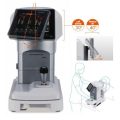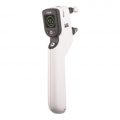-
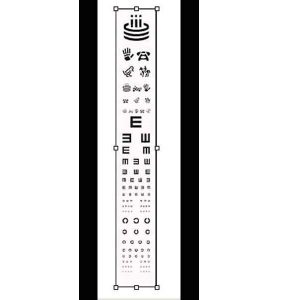 Projector Slide Replacements Child Acuity Projector Slide Allen Figures, Tumbling "E", Landolt "C" This family of projector slides are designed for testing all ages. Made of high quality photographic film, sealed between two pieces of glass to ensure sharp optotypes to maintain the integrity of your exam. Each slide must be adjusted for use on different length testing lanes.
Projector Slide Replacements Child Acuity Projector Slide Allen Figures, Tumbling "E", Landolt "C" This family of projector slides are designed for testing all ages. Made of high quality photographic film, sealed between two pieces of glass to ensure sharp optotypes to maintain the integrity of your exam. Each slide must be adjusted for use on different length testing lanes. -
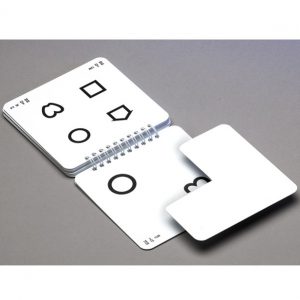 The Single Symbol Book is ideal for people who cannot perform when tested with a line test. This book can help determine the best resolution of the visual pathway in a child/adult with amblyopia or impaired vision. Single optotype line sizes from 20/200 to 20/8 (6/60 to 6/2.4) equivalent.
The Single Symbol Book is ideal for people who cannot perform when tested with a line test. This book can help determine the best resolution of the visual pathway in a child/adult with amblyopia or impaired vision. Single optotype line sizes from 20/200 to 20/8 (6/60 to 6/2.4) equivalent. -
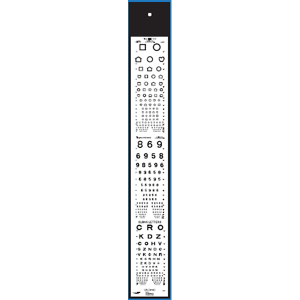 Designed for use in manual Chart Projectors including products from: R.H. Burton, Marco, Reichart, Topcon, and Woodlyn. Includes test for: → LEA Symbols® 20/100 – 20/10 (18 Lines) → LEA Numbers® (16 Lines) (Multiple Lines 20/50 – 20/10) → Sloan Numbers 20/100 – 20/10 (16 Lines) (Multiple Lines 20/50 – 20/10) Item #: VA3202
Designed for use in manual Chart Projectors including products from: R.H. Burton, Marco, Reichart, Topcon, and Woodlyn. Includes test for: → LEA Symbols® 20/100 – 20/10 (18 Lines) → LEA Numbers® (16 Lines) (Multiple Lines 20/50 – 20/10) → Sloan Numbers 20/100 – 20/10 (16 Lines) (Multiple Lines 20/50 – 20/10) Item #: VA3202 -
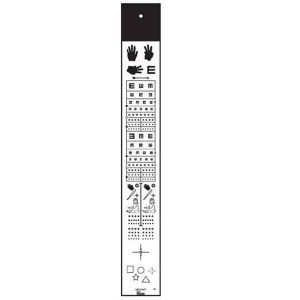 Child Vectorgraphic Projector Slide → Training Demonstration → Tumbling E Monocular 20/100 – 20/15 (9 Lines) → Acuity Balance 20/30 – 20/20 (3 Lines) → Tumbling E Binocular 20/30 – 20/15 (4 Lines) → Fixation Disparity with Fusion Lock → Stereopsis 215 - 40 seconds of arc
Child Vectorgraphic Projector Slide → Training Demonstration → Tumbling E Monocular 20/100 – 20/15 (9 Lines) → Acuity Balance 20/30 – 20/20 (3 Lines) → Tumbling E Binocular 20/30 – 20/15 (4 Lines) → Fixation Disparity with Fusion Lock → Stereopsis 215 - 40 seconds of arc -
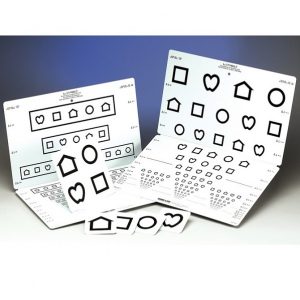 Lea SYMBOLS® 15 Line Folding Distance Chart For screening or testing individuals beginning at age 2 1/2. Proportionally-spaced lines; line sizes range from 20/200 to 20/8 (6/60 to 6/2.4) equivalent. 50% spaced rectangle (Massachusetts Visual Acuity Test format) with line sizes from 20/100 to 20/8 (6/30 to 6/2.4) equivalent. Has a hole for hanging the chart on the wall.
Lea SYMBOLS® 15 Line Folding Distance Chart For screening or testing individuals beginning at age 2 1/2. Proportionally-spaced lines; line sizes range from 20/200 to 20/8 (6/60 to 6/2.4) equivalent. 50% spaced rectangle (Massachusetts Visual Acuity Test format) with line sizes from 20/100 to 20/8 (6/30 to 6/2.4) equivalent. Has a hole for hanging the chart on the wall. -
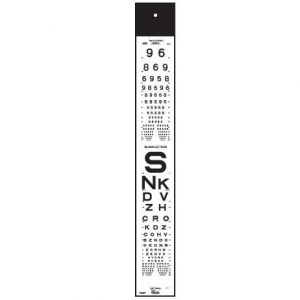 Designed for use in manual Chart Projectors including products from: R.H. Burton, Marco, Reichart, Topcon, and Woodlyn. Includes test for: → LEA Numbers® 20/125 – 20/10 (17 Lines) (Multiple Lines 20/50 – 20/10) → Sloan Letters 20/400 – 20/10 (20 Lines) (Multiple Lines 20/50 – 20/10) Item #: VA3201
Designed for use in manual Chart Projectors including products from: R.H. Burton, Marco, Reichart, Topcon, and Woodlyn. Includes test for: → LEA Numbers® 20/125 – 20/10 (17 Lines) (Multiple Lines 20/50 – 20/10) → Sloan Letters 20/400 – 20/10 (20 Lines) (Multiple Lines 20/50 – 20/10) Item #: VA3201 -
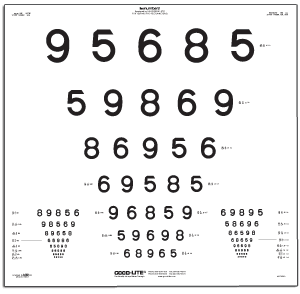 Adult LEA NUMBERS® chart for ETDRS Illuminated light boxes. Fits all existing ETDRS cabinets including both the ESV3000 and ESC2000. LEA NUMBERS® ETDRS chart contains optotypes in proportionally spaced (logMAR) lines; lines range from 20/200 to 20/8 (6/60 to 6/2.4) equivalent, 0.10 to 2.50. Fits in ESV3000 ETDRS illuminated cabinet.
Adult LEA NUMBERS® chart for ETDRS Illuminated light boxes. Fits all existing ETDRS cabinets including both the ESV3000 and ESC2000. LEA NUMBERS® ETDRS chart contains optotypes in proportionally spaced (logMAR) lines; lines range from 20/200 to 20/8 (6/60 to 6/2.4) equivalent, 0.10 to 2.50. Fits in ESV3000 ETDRS illuminated cabinet. -
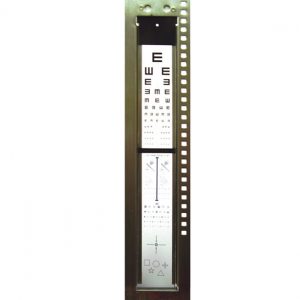 Vectographic Projector Slide Pediatric Slide This pediatric projector slide test depth perception and binocularity under distance conditions. The top portion of each slide is a standard non-vectographic projector slide. The bottom portion is a vetographic slide that contains suppression control targets, a distance stereo acuity test, fixation disparity and binocular balance. Slide fits most AO and Marco projectors, and there are adaptable to a 10' or 20' lane. REQUIRES POLARIZING SCREEN.
Vectographic Projector Slide Pediatric Slide This pediatric projector slide test depth perception and binocularity under distance conditions. The top portion of each slide is a standard non-vectographic projector slide. The bottom portion is a vetographic slide that contains suppression control targets, a distance stereo acuity test, fixation disparity and binocular balance. Slide fits most AO and Marco projectors, and there are adaptable to a 10' or 20' lane. REQUIRES POLARIZING SCREEN. -
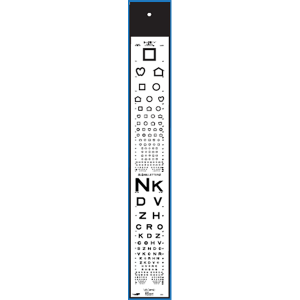 Designed for use in manual Chart Projectors including products from: R.H. Burton, Marco, Reichart, Topcon, and Woodlyn. Includes test for: → LEA Symbols® 20/100 – 20/10 (18 Lines) → LEA Numbers® (16 Lines) (Multiple Lines 20/50 – 20/10) → Sloan Numbers 20/100 – 20/10 (16 Lines) (Multiple Lines 20/50 – 20/10) Item #: VA3203
Designed for use in manual Chart Projectors including products from: R.H. Burton, Marco, Reichart, Topcon, and Woodlyn. Includes test for: → LEA Symbols® 20/100 – 20/10 (18 Lines) → LEA Numbers® (16 Lines) (Multiple Lines 20/50 – 20/10) → Sloan Numbers 20/100 – 20/10 (16 Lines) (Multiple Lines 20/50 – 20/10) Item #: VA3203 -
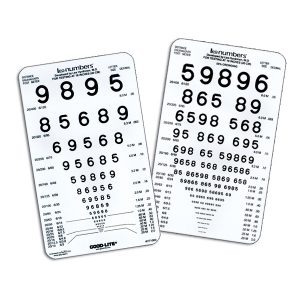 This test is designed for testing patients' visual acuity during rounds and in similar situations with a need for quick testing. The test has proportionally spaced (logMAR) lines on one side and tightly crowded lines (50% spacing) on the reverse side Line sizes from 20/400 to 20/10 (6/120 to 6/3) equivalent, 0.05 to 2.00. 3.75" x 6.25" (9.5 cm x 15.9 cm).
This test is designed for testing patients' visual acuity during rounds and in similar situations with a need for quick testing. The test has proportionally spaced (logMAR) lines on one side and tightly crowded lines (50% spacing) on the reverse side Line sizes from 20/400 to 20/10 (6/120 to 6/3) equivalent, 0.05 to 2.00. 3.75" x 6.25" (9.5 cm x 15.9 cm). -
This screening battery is designed to detet vision problems in the pre-school population. It includes a test for visual acuity, eye alignment, binocular funtcion, farsightedness, lazy eye (amblyopia), and more. Utilizing new test such as the school bus test, this screening test for a great number of problems in a short period of time. This screening battery of test was designed for use by school personnel of members of service clubs such as Lions or Kiwanis with minimal training. Many test are pass/fail
-
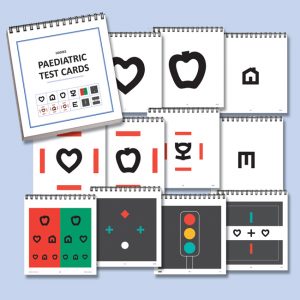 Collection of 66 test cards for use during examination of children. Hanks Pediatric Optotypes - Calibrated from 6/60 to 6/4. Designed for this purpose and tested in clinical trials to confirm recognition of the symbols by young children. Landolt C & Illiterate E Optotypes are also included - Calibrated from 6/60 to 6/4. Color Vision Screening - Pseudo-isochromatic plates with letters, numbers, circles and trails. Quality Production - Each card is matt laminated and encapsulated for long life protection. Actual size of each card is 108 x 112mm. Item #: AUPTC
Collection of 66 test cards for use during examination of children. Hanks Pediatric Optotypes - Calibrated from 6/60 to 6/4. Designed for this purpose and tested in clinical trials to confirm recognition of the symbols by young children. Landolt C & Illiterate E Optotypes are also included - Calibrated from 6/60 to 6/4. Color Vision Screening - Pseudo-isochromatic plates with letters, numbers, circles and trails. Quality Production - Each card is matt laminated and encapsulated for long life protection. Actual size of each card is 108 x 112mm. Item #: AUPTC


